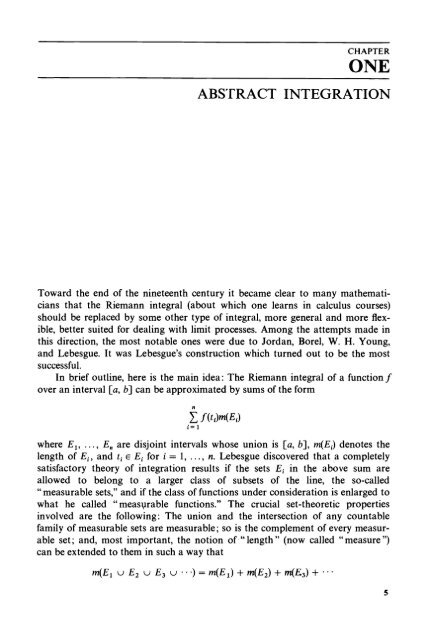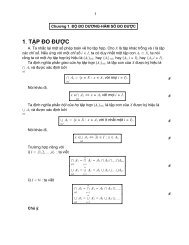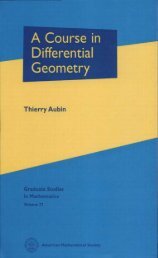- Page 2: REAL AND COMPLEX ANALYSIS
- Page 5 and 6: REAL AND COMPLEX ANALYSISINTERNATIO
- Page 8 and 9: CONTENTSPrefacexiiiPrologue: The Ex
- Page 10: CONTENTS ixChapter 10Elementary Pro
- Page 16 and 17: PROLOGUETHE EXPONENTIAL FUNCTIONThi
- Page 18 and 19: PROLOGUE: THE EXPONENTIAL FUNCTION
- Page 22 and 23: ABSTRACT INTEGRA nON 7If no two mem
- Page 24 and 25: ABSTRACT INTEGRA nON 9It would perh
- Page 26 and 27: ABSTRACT INTEGRATION 111.8 Theorem
- Page 28 and 29: ABSTRACT INTEGRATION 131.12 Theorem
- Page 30 and 31: ABSTRACT INTEGRATION 15Corollaries(
- Page 32 and 33: ABSTRACT INTEGRA nON 17As the proof
- Page 34 and 35: ABSTRACT INTEGRATION 19The cancella
- Page 36 and 37: ABSTRACT INTEGRATION 21Next, let s
- Page 38 and 39: Corollary If aij :2= ° for i and j
- Page 40 and 41: ABSTRACT INTEGRATION 25each of thes
- Page 42 and 43: ABSTRACT INTEGRA nON 27PROOF Since
- Page 44 and 45: ABSTRACT INTEGRA TlON 291.37 The fa
- Page 46 and 47: ABSTRACT INTEGRATION 31PROOF Let a
- Page 48 and 49: CHAPTERTWOPOSITIVE BOREL MEASURESVe
- Page 50 and 51: POSITIVE BOREL MEASURES 35[The conv
- Page 52 and 53: POSITIVE BOREL MEASURES 372.6 Theor
- Page 54 and 55: POSITIVE BOREL MEASURES 39will mean
- Page 56 and 57: POSITIVE BOREL MEASURES 41(b) I-'(K
- Page 58 and 59: POSITIVE BOREL MEASURES 43Put V = U
- Page 60 and 61: POSITIVE BOREL MEASURES 45PROOF If
- Page 62 and 63: POSITIVE BOREL MEASURES 47Since hi
- Page 64 and 65: POSITIVE BOREL MEASURES 49PROOF Put
- Page 66 and 67: POSITIVE BOREL MEASURES 51(c) m is
- Page 68 and 69: POSITIVE BOREL MEASURES 532.21 Rema
- Page 70 and 71:
POSITIVE BOREL MEASURES 55If T is o
- Page 72 and 73:
POSITIVE BOREL MEASURES 57Sincethe
- Page 74 and 75:
POSITIVE BOREL MEASURES S913 Is it
- Page 76 and 77:
CHAPTERTHREELP-SPACESConvex Functio
- Page 78 and 79:
If-SPACES 63(4) becomesexp U (Xl +
- Page 80 and 81:
I!'-SPACES 65Hence the left side of
- Page 82 and 83:
H-SPACES 67Suppose j, g, and h are
- Page 84 and 85:
I!-SPACES 69The simple functions pl
- Page 86 and 87:
l!'-SPACES 71Given / E Co(X) and
- Page 88 and 89:
If-SPACES 73(b) Prove that equality
- Page 90 and 91:
I!'-SPACES 75(b) If 1 :5 P < 00 and
- Page 92 and 93:
ELEMENTARY HILBERT SPACE THEORY 774
- Page 94 and 95:
ELEMENTARY HILBERT SPACE THEORY 79I
- Page 96 and 97:
ELEMENTARY HILBERT SPACE THEORY 81P
- Page 98 and 99:
ELEMENTARY HILBERT SPACE THEORY 834
- Page 100 and 101:
ELEMENTARY IDLBERT SPACE THEORY 8S4
- Page 102 and 103:
ELEMENTARY HILBERT SPACE THEORY 87(
- Page 104 and 105:
ELEMENTARY HILBERT SPACE THEORY 89W
- Page 106 and 107:
ELEMENTARY HILBERT SPACE THEORY 91T
- Page 108 and 109:
ELEMENTARY HILBERT SPACE THEORY 93M
- Page 110 and 111:
CHAPTERFIVEEXAMPLES OF BANACH SPACE
- Page 112 and 113:
EXAMPLES OF BANACH SPACE lECHNIQUES
- Page 114 and 115:
EXAMPLES OF BANACH SPACE TECHNIQUES
- Page 116 and 117:
EXAMPLES OF BANACH SPACE TECHNIQUES
- Page 118 and 119:
EXAMPLES OF BANACH SPACE TECHNIQUES
- Page 120 and 121:
EXAMPLES OF BANACH SPACE TECHNIQUES
- Page 122 and 123:
EXAMPLES OF BANACH SPACE TECHNIQUES
- Page 124 and 125:
EXAMPLES OF BANACH SPACE TECHNIQUES
- Page 126 and 127:
EXAMPLES OF BANACH SPACE TECHNIQUES
- Page 128 and 129:
EXAMPLFS OF BANACH SPACE TECHNIQUES
- Page 130 and 131:
EXAMPLES OF BANACH SPACE TECHNIQUES
- Page 132 and 133:
COMPLEX MEASURES 117This notation i
- Page 134 and 135:
COMPLEX MEASURES 119We have thus sp
- Page 136 and 137:
COMPLEX MEASURES 121(f) Since A2 .1
- Page 138 and 139:
COMPLEX MEASURES 123Hence g(x) E [0
- Page 140 and 141:
COMPLEX MEASURES 125By analogy with
- Page 142 and 143:
COMPLEX MEASURES 127then
- Page 144 and 145:
COMPLEX MEASURES 129The first part
- Page 146 and 147:
COMPLEX MEASURES 131Once we have th
- Page 148 and 149:
COMPLEX MEASURES 1334 Suppose 1 :5
- Page 150 and 151:
CHAPTERSEVENDIFFERENTIATIONIn eleme
- Page 152 and 153:
DIFFERENTIATION 1377.3 Lemma If W i
- Page 154 and 155:
DIFFERENTIATION 139PROOF Definefor
- Page 156 and 157:
DIFFERENTIA nON 141PROOF Let x be a
- Page 158 and 159:
DIFFERENTIATION 1437.14 Theorem Sup
- Page 160 and 161:
DIFFERENTIATION 1452- n - 1
- Page 162 and 163:
DIFFERENTIATION 147Assume next that
- Page 164 and 165:
DIFFERENTIATION 149The next theorem
- Page 166 and 167:
DIFFERENTIATION 151stronger hypothe
- Page 168 and 169:
DIFFERENTIATION, 153Since r" = m(B(
- Page 170 and 171:
DIFFERENTIATION 155Theorem 7.8 tell
- Page 172 and 173:
DIFFERENTIATION 1577 Construct a co
- Page 174 and 175:
DIFFERENTIATION 15921 Iffis a real
- Page 176 and 177:
INTEGRATION ON PRODUCT SPACES 161If
- Page 178 and 179:
INTEGRATION ON PRODUCT SPACES 163Pr
- Page 180 and 181:
INTEGRATION ON PRODUCT SPACES 165(c
- Page 182 and 183:
INTEGRATION ON PRODUCT SPACES 167To
- Page 184 and 185:
INTEGRATION ON PRODUCT SPACES 169Th
- Page 186 and 187:
INTEGRATION ON PRODUCT SPACES 171wh
- Page 188 and 189:
INTEGRATION ON PRODUCT SPACES 173Fo
- Page 190 and 191:
INTEGRATION ON PRODUCT SPACES 175S
- Page 192 and 193:
INTEGRATION ON PRODUCT SPACES 177Su
- Page 194 and 195:
FOURIER TRANSFORMS 179The formal pr
- Page 196 and 197:
FOURIER TRANSFORMS 181Let us see wh
- Page 198 and 199:
FOURIER TRANSFORMS 183The integrand
- Page 200 and 201:
FOURIER lRANSFORMS 185and Theorem 3
- Page 202 and 203:
FOURIER lRANSFORMS 187Theorem 9.2(d
- Page 204 and 205:
FOURIER TRANSFORMS 189orthogonal pr
- Page 206 and 207:
FOURIER TRANSFORMS 191follows: We k
- Page 208 and 209:
FOURIER TRANSFORMS 193Thenf'! (d (X
- Page 210 and 211:
FOURIER TRANSFORMS 195What does (*)
- Page 212 and 213:
ELEMENTARY PROPERTIES OF HOLOMORPHI
- Page 214 and 215:
ELEMENTARY PROPERTIES OF HOLOMORPHI
- Page 216 and 217:
ELEMENTARY PROPERTIES OF HOLOMORPHI
- Page 218 and 219:
ELEMENTARY PROPERTIES OF HOLOMORPHI
- Page 220 and 221:
ELEMENTARY PROPERTIES OF HOLOMORPlD
- Page 222 and 223:
ELEMENTARY PROPERTIES OF HOLOMORPHI
- Page 224 and 225:
ELEMENTARY PROPERTIES OF HOLOMORPHI
- Page 226 and 227:
ELEMENTARY PROPERTIES OF HOLOMORPHI
- Page 228 and 229:
ELEMENTARY PROPERTIES OF HOLOMORPHI
- Page 230 and 231:
ELEMENTARY PROPERTIES OF HOLOMORPHI
- Page 232 and 233:
ELEMENTARY PROPERTIES OF HOLOMORPHI
- Page 234 and 235:
ELEMENTARY PROPERTIES OF HOLOMORPHI
- Page 236 and 237:
ELEMENTARY PROPERTIES OF HOLOMORPHI
- Page 238 and 239:
ELEMENTARY PROPERTIES OF HOLOMORPHI
- Page 240 and 241:
ELEMENTARY PROPERTIES OF HOLOMORPlD
- Page 242 and 243:
ELEMENTARY PROPERTIES OF HOLOMORPHI
- Page 244 and 245:
ELEMENTARY PROPERTIES OF HOLOMORPHI
- Page 246 and 247:
CHAPTERELEVENHARMONIC FUNCTIONSThe
- Page 248 and 249:
HARMONIC FUNCTIONS 233The Poisson I
- Page 250 and 251:
HARMONIC FUNCTIONS 235Note: This th
- Page 252 and 253:
HARMONIC FUNCTIONS 237The Mean Valu
- Page 254 and 255:
HARMONIC FUNCTIONS 239Hence
- Page 256 and 257:
HARMONIC FUNCTIONS 241The regions n
- Page 258 and 259:
HARMONIC FUNCTIONS 243Hence, settin
- Page 260 and 261:
HARMONIC FUNCTIONS 245(a) If P. is
- Page 262 and 263:
HARMONIC FUNCTIONS 247PROOF To say
- Page 264 and 265:
HARMONIC FUNCTIONS 249As before, Lo
- Page 266 and 267:
HARMONIC FUNCTIONS 251If {u.} is a
- Page 268 and 269:
CHAPTERTWELVETHE MAXIMUM MODULUS PR
- Page 270 and 271:
THE MAXIMUM MODULUS PRINCIPLE 255Th
- Page 272 and 273:
THE MAXIMUM MODULUS PRINCIPLE 257Fi
- Page 274 and 275:
THE MAXIMUM MODULUS PRINCIPLE 259Fi
- Page 276 and 277:
THE MAXIMUM MODULUS PRINCIPLE 26112
- Page 278 and 279:
THE MAXIMUM MODULUS PRINCIPLE 263No
- Page 280 and 281:
THE MAXIMUM MODULUS PRINCIPLE 265Su
- Page 282 and 283:
APPROXIMATIONS BY RATIONAL FUNCTION
- Page 284 and 285:
APPROXIMATIONS BY RATIONAL FUNCTION
- Page 286 and 287:
APPROXIMA nONS BY RA nONAL FUNCTION
- Page 288 and 289:
APPROXIMA TIO~S BY RATIONAL FUNCTIO
- Page 290 and 291:
APPROXIMATIONS BY RATIONAL FUNCTION
- Page 292 and 293:
APPROXIMATIONS BY RATIONAL FUNCTION
- Page 294 and 295:
CONFORMAL MAPPING 279Here /'(zo) =
- Page 296 and 297:
CONFORMAL MAPPING 281Let us discuss
- Page 298 and 299:
CONFORMAL MAPPING 283Under these co
- Page 300 and 301:
CONFORMAL MAPPING 28514.9 Remarks T
- Page 302 and 303:
CONFORMAL MAPPING 287Divide Eqs. (5
- Page 304 and 305:
CONFORMAL MAPPING 289PROOF Iff= I/(
- Page 306 and 307:
CONFORMAL MAPPING 291Theorem 14.18(
- Page 308 and 309:
CONFORMAL MAPPING 293Put y(t) = .JR
- Page 310 and 311:
CONFORMAL MAPPING 29518 Suppose 0 i
- Page 312 and 313:
CONFORMAL MAPPING 297(d) Let ex be
- Page 314 and 315:
ZEROS OF HOLOMORPHIC FUNCTIONS 299I
- Page 316 and 317:
ZEROS OF HOLOMORPHIC FUNCTIONS 301c
- Page 318 and 319:
ZEROS OF HOLOMORPHIC FUNCTIONS 303I
- Page 320 and 321:
ZEROS OF HOLOMORPlDC FUNCTIONS 305a
- Page 322 and 323:
ZEROS OF HOWMORPHIC FUNCTIONS 307Je
- Page 324 and 325:
ZEROS OF HOLOMORPIDC FUNCTIONS 309a
- Page 326 and 327:
ZEROS OF HOWMORPHIC FUNCTIONS 311is
- Page 328 and 329:
ZEROS OF HOLOMORPHIC FUNCTIONS 313t
- Page 330 and 331:
ZEROS OF HOLOMORPHIC FUNCTIONS 315i
- Page 332 and 333:
ZEROS OF HOLOMORPHIC FUNCTIONS 317P
- Page 334 and 335:
CHAPTERSIXTEENANALYTIC CONTINUATION
- Page 336 and 337:
ANALYTIC CONTINUATION 321integers.
- Page 338 and 339:
ANALYTIC CONTINUATION 323the radius
- Page 340 and 341:
ANALYTIC CONTINUATION 325There are
- Page 342 and 343:
ANALYTIC CONTINUATION 32716.15 Tbeo
- Page 344 and 345:
ANALYTIC CONTINUATION 329We claim t
- Page 346 and 347:
ANALYTIC CONTINUATION 331PROOF Let
- Page 348 and 349:
ANALYTIC CONTINUATION 333P(f1' 01)
- Page 350 and 351:
CHAPTERSEVENTEENThis chapter is dev
- Page 352 and 353:
HP-SPACES 337some r > 0 we have D(z
- Page 354 and 355:
HP-SPACES 339PROOF Note first thatI
- Page 356 and 357:
For each z E U, 11 - e-ilz I and P(
- Page 358 and 359:
log I 9 I are 0 a.e. (Theorem 11.22
- Page 360 and 361:
Since Ilog+ u - log+ V I ~ I u - v
- Page 362 and 363:
X n , the one-dimensional spaces sp
- Page 364 and 365:
So there exists a qJ E Y such that
- Page 366 and 367:
HP-SPACES 351Let us recall that eve
- Page 368 and 369:
5 Suppose fe HP, qJ e H(U), and qJ(
- Page 370 and 371:
ffI' -SPACES 355exists (and is fini
- Page 372 and 373:
ELEMENTARY TIIEORY OF BANACH ALGEBR
- Page 374 and 375:
ELEMENTARY THEORY OF BANACH ALGEBRA
- Page 376 and 377:
ELEMENTARY THEORY OF BANACH ALGEBRA
- Page 378 and 379:
ELEMENTARY THEORY OF BANACH ALGEBRA
- Page 380 and 381:
ELEMENTARY THEORY OF BANACH ALGEBRA
- Page 382 and 383:
ELEMENTARY THEORY OF BANACH ALGEBRA
- Page 384 and 385:
ELEMENTARY THEORY OF BANACH ALGEBRA
- Page 386 and 387:
CHAPTERNINETEENHOLOMORPHIC FOURIER
- Page 388 and 389:
HOLOMORPHIC FOURIER TRANSFORMS 373a
- Page 390 and 391:
HOLOMORPHIC FOURIER TRANSFORMS 3751
- Page 392 and 393:
HOLOMORPHIC FOURIER TRANSFORMS 377i
- Page 394 and 395:
HOLOMORPHIC FOURIER TRANSFORMS 379C
- Page 396 and 397:
HOLOMORPHIC FOURIER TRANSFORMS 381T
- Page 398 and 399:
HOLOMORPHIC FOURIER TRANSFORMS 383F
- Page 400 and 401:
HOLOMORPHIC FOURIER TRANSFORMS 385h
- Page 402 and 403:
UNIFORM APPROXIMATION BY POLYNOMIAL
- Page 404 and 405:
UNIFORM APPROXIMATION BY POLYNOMIAL
- Page 406 and 407:
UNIFORM APPROXIMATION BY pOLYNOMIAL
- Page 408 and 409:
UNIFORM APPROXIMATION BY POLYNOMIAL
- Page 410 and 411:
APPENDIXHAUSDORFF'S MAXIMALITY THEO
- Page 412 and 413:
NOTES AND COMMENTSChapter 1The firs
- Page 414 and 415:
NOTES AND COMMENTS 399Chapter 6Sec.
- Page 416 and 417:
NOTES AND COMMENTS 401orthonormal s
- Page 418:
NOTES AND COMMENTS 403CbapterlOSee
- Page 421 and 422:
406 BIBLIOGRAPHY24. F. Riesz and B.
- Page 423 and 424:
408 LIST OF SPECIAL SYMBOLS AND ABB
- Page 425 and 426:
410 INDEXCartesian product, 7,160Ca
- Page 427 and 428:
412 INDEXHalmos, P. R., 398,403Hard
- Page 429 and 430:
414 INDEXOuter regular set, 47Overc
- Page 431:
416 INDEXUniform continuity, 51Unif





